College Algebra
Austin Community College
All 13 results
Sort by
This collection is well-written and detailed. Its section 1-3 will help through the first 3 weeks of class!
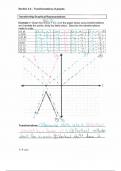
-
charts
- Class notes • 4 pages • 2023
- Available in package deal
-
- $7.99
- + learn more
Transformation algebra involves the study of how various transformations affect algebraic equations and functions. These transformations include translations, reflections, stretches, compressions, and shifts. By applying these transformations, we can modify the shape, position, and characteristics of equations and functions. For example, a translation shifts the graph horizontally or vertically, while a reflection flips the graph across a specific axis. Stretches and compressions change the scal...
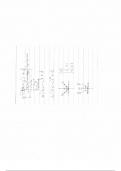
-
introduction to transformations
- Class notes • 7 pages • 2023
- Available in package deal
-
- $8.49
- + learn more
Transformation algebra involves the study of how various transformations affect algebraic equations and functions. These transformations include translations, reflections, stretches, compressions, and shifts. By applying these transformations, we can modify the shape, position, and characteristics of equations and functions. For example, a translation shifts the graph horizontally or vertically, while a reflection flips the graph across a specific axis. Stretches and compressions change the scal...
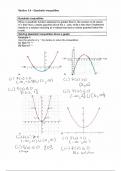
-
solving quadratic inequalities given a graph
- Class notes • 1 pages • 2023
- Available in package deal
-
- $8.99
- + learn more
Solving quadratic inequalities given a graph in algebra involves determining the intervals or regions on the graph where the quadratic inequality is true. The graph of a quadratic function is a parabola, and the inequality can be expressed in the form ax^2 + bx + c > 0, ax^2 + bx + c < 0, ax^2 + bx + c ≥ 0, or ax^2 + bx + c ≤ 0, depending on the specific inequality. To solve the quadratic inequality, we examine the shape of the parabola and identify the regions where the graph is above...
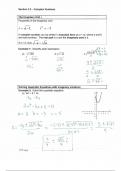
-
solving quadratic equations with imaginary solutions
- Class notes • 2 pages • 2023
- Available in package deal
-
- $9.49
- + learn more
Solving quadratic equations with imaginary solutions involves finding the values of the variable that satisfy the equation but result in complex or imaginary numbers. A quadratic equation is typically written in the form ax^2 + bx + c = 0, where 'a', 'b', and 'c' are coefficients and 'x' is the variable. When the discriminant, which is b^2 - 4ac, is negative, the quadratic equation does not have real solutions. Instead, it yields complex solutions in the form of a+bi, where 'a' and 'b...
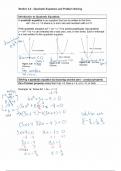
-
solving quadratic equations
- Class notes • 7 pages • 2023
- Available in package deal
-
- $7.99
- + learn more
Quadratic functions are a fundamental concept in algebra that involve a second-degree polynomial equation. They can be written in the form f(x) = ax^2 + bx + c, where 'a', 'b', and 'c' are constants, and 'x' represents the variable. Quadratic functions are characterized by a curved graph called a parabola. The shape of the parabola is determined by the coefficient 'a'. If 'a' is positive, the parabola opens upwards, and if 'a' is negative, it opens downwards. Quadratic functions ha...
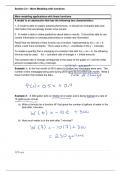
-
solving piecewise- defined functions
- Class notes • 8 pages • 2023
- Available in package deal
-
- $7.99
- + learn more
Solving piecewise-defined functions in algebra involves determining the output values based on different rules or equations depending on the given input values or intervals. Piecewise functions consist of multiple rules or equations that define the function's behavior over different intervals. To solve a piecewise-defined function, we evaluate the appropriate equation or rule based on the given input value or interval. We follow the conditions specified by the intervals and apply the correspond...
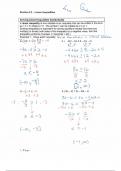
-
solving linear and compound linear inequalities
- Class notes • 2 pages • 2023
- Available in package deal
-
- $7.99
- + learn more
In algebra, solving linear and compound linear inequalities involves finding the values of a variable that satisfy the given inequality statement. Linear inequalities are expressed using inequality symbols such as < (less than), > (greater than), ≤ (less than or equal to), or ≥ (greater than or equal to). To solve a linear inequality, we perform similar operations on both sides of the inequality sign to isolate the variable. The solution is represented as an interval or a set of values...
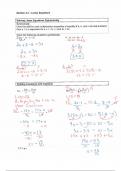
-
distance, rate, time, applications of finance
- Class notes • 6 pages • 2023
- Available in package deal
-
- $7.99
- + learn more
In summary, the application of linear models in finance using algebraic concepts enables businesses and individuals to make informed decisions about costs, revenues, budgets, investments, and financial planning. By leveraging these models, financial professionals can analyze financial data, evaluate performance, project outcomes, and optimize their financial strategies for achieving their goals.
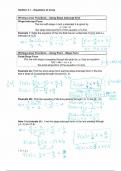
-
point-slope form
- Class notes • 6 pages • 2023
- Available in package deal
-
- $7.99
- + learn more
Point-Slope Form: The point-slope form is an algebraic representation of a linear function that expresses the relationship between a point on the graph and the slope of the line. It is written as y - y1 = m(x - x1), where (x1, y1) represents a point on the line, and 'm' is the slope. This form is particularly useful for determining the equation of a line when given a point and its slope. Intercepts: Intercepts are points where a line intersects either the x-axis or the y-axis. In linear fun...



